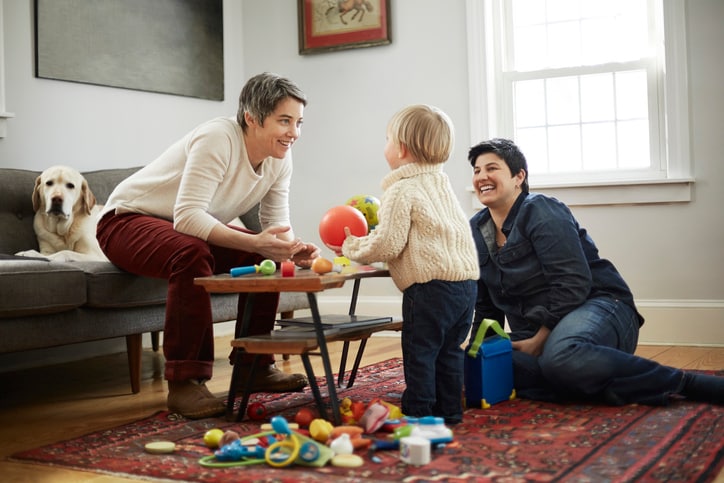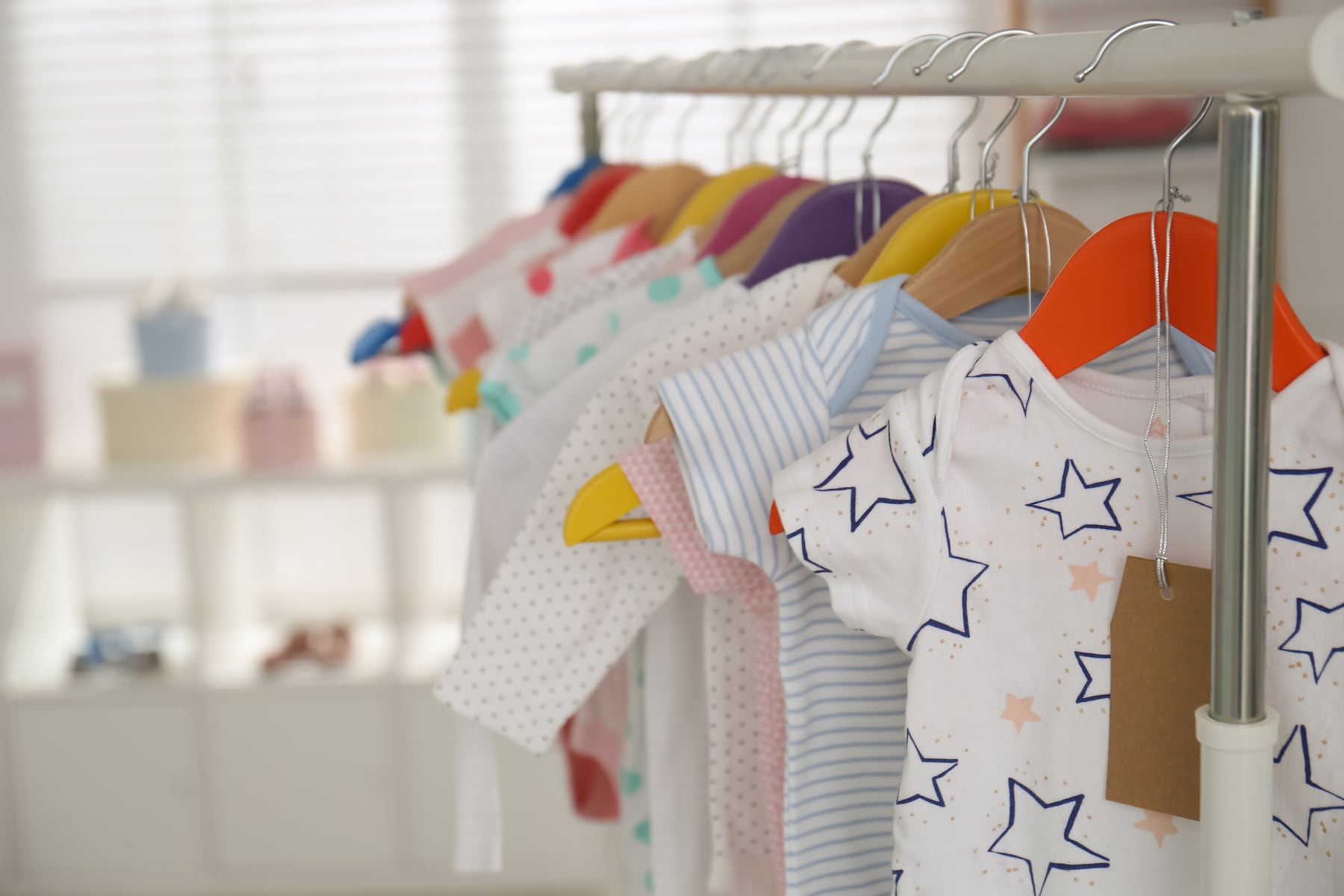In this article
My oldest child, who is now 12 years old, was still in utero when my ex-partner and I began our search for a day care for her. We knew from friends who were already parents that finding quality care meant being on a waitlist or committing to and paying for a spot in a classroom before our child was born. For a queer couple like us, though, quality meant more than finding a center that took care of her physical and emotional needs. We needed our baby and queer family to be accepted and affirmed.
My ex and I were adamant that any difference in our family structure, especially when compared to the other families in the classroom, would be celebrated and not othered or ignored. I needed to know that we would be treated with respect and kindness by staff and other families who were in my child’s class. My then 6-month-old daughter deserved to receive an extension of the care she received at home and with family friends.
We are fortunate to live in a progressive and queer-affirming place, but we still had concerns when we started our hunt. While inclusivity is often a sliding scale and can always be improved upon, here are ways to advocate for yourself and find day care or a child care provider who will welcome and fight for your family.
Key takeaways
- Parents should ask about pronouns, inclusion policies, and visible LGBTQIA+ support when evaluating child care centers.
- Providers need to intentionally create inclusive spaces by hiring diverse staff and using inclusive language and materials.
- Parents may need to educate providers, set boundaries, and be open to conflict resolution if issues arise.
What LGBTQIA+ inclusive child care looks like
Word of mouth from other queer parents who have attended a day care you are interested in goes a long way in finding out how providers work with LGBTQIA+ families.
Sarah Martin, who lives in Kentucky with her wife and two kids, experienced this firsthand. Her kids started in day care as infants. “One of our best tools was getting references from our own friends that had our family’s best interest at heart,” says Martin. “Just like other families we wanted to make sure that there wasn’t a lot of turnover at the facility. When there is a lot of turnover, you don’t get to know and trust individuals, which I believe is key to making sure our kids were in a space that was LGBTQ+ affirming.”
Nikkya Hargrove, who lives in Connecticut with her wife and their three kids, started to visit day care centers with her wife when their son was a toddler and twins were babies. They wanted to get a feel for the culture of the center as well as who the other families were. “We wanted, like all parents, to know that when we left them for work, they’d be safe and cared for,” she says.
Creating LGBTQIA+ inclusive classrooms doesn’t need to be any harder than creating ones that exclude (even if not on purpose) same-sex or transgender parents. But it does require a center or child care provider to be intentional, either with their policies and promises to be affirming of all families or with their desire to do better.
“One of our best tools was getting references from our own friends that had our family’s best interest at heart.”
— Sarah Martin, Kentucky-based mom of two
How to ensure LGBTQIA+ inclusive child care
Finding teachers who are not only comfortable with gay or transgender people and couples, but who are excited by the diversity they bring to the community is the goal. When looking for LGBTQIA+ inclusive care, parents need child care providers who will work with them to foster allyship in the classroom for themselves and their children.
Ask these questions
When touring a site or considering a particular day care or child care service, ask if they have worked with other families like yours and if they would be willing to talk to you, recommends Rebecca Willman, chief community engagement and programs officer at Family Equality.
She also advises asking the following questions, as a provider’s responses will give you a good sense of how affirming a space will be for their family.
- Are pronouns for teachers listed on the website directory or email signatures?
- Does a center’s list of values include equity, inclusion, and belonging?
- When meeting in person, does a staff member offer their pronouns and ask for yours?
- Does a provider ask about your parental identity or make assumptions?
- Are their Pride or trans flags and stickers visible?
- Does the center offer gender neutral bathrooms?
- What does the curriculum look like in terms of racial and LGBTQIA+ inclusion?
Take note of inclusive practices
Gender-neutral language on forms, access to children’s books that are both mirrors and windows that represent all types of families and teachers who actively encourage all genders to play with all types of toys are the basics that providers should offer to create welcoming spaces.
If centers don’t already have these inclusive practices in place, it doesn’t necessarily mean they aren’t willing to make changes. It is, however, another layer of education and emotional labor queer parents and parents looking for queer friendly providers need to do to ensure their kids are in inclusive spaces.
Martin says that each time her children moved into a new classroom, she had to make sure the new teacher was comfortable with her providing books that showcased LGBTQIA+ families, but eventually she and her wife moved their kids to a Montessori school for their more progressive and inclusive curriculum.
Consider the community as a whole
Inclusivity goes beyond the policies of the center and often needs a whole village approach from other families in the classroom. “At their current school, teachers are comfortable with LGBTQ+ families, but they’re also better at helping other kids positively approach family differences,”Martin says. “[Other families] at our school seek [inclusion] and are excited about their kids being in spaces that are diverse.”
For Hargrove, finding the right day care meant finding providers who seemed genuinely interested in getting to know and understand her family. She looked for subtle shifts in people’s expressions when she said “my wife” and made sure teachers made eye contact with her while getting to know her family. She also paid close attention to how caregivers asked for contact information, either verbally or on paper, and she was quick to correct people if they assumed the presence of “Dad.”
How to find more personalized LGBTQIA+ inclusive care
Not all LGBTQIA+ families want to send their child to a day care setting, though, and prefer to find a nanny instead. This may be for safety reasons or simply because they want more personalized care.
Danielle Sadler, marketing director at Adventure Nannies, understands this. To make sure staff are meeting the needs of queer parents, Sadler says a company should ensure that staff undergoes training and education on LGBTQIA+ issues, including terminology and pronoun usage. But what makes for inclusive care is also in understanding the unique needs and challenges queer families and individual families face.
“In an effort to continuously grow and expand our understanding of the challenges faced by the LGBTQIA+ community, we actively engage with LGBTQIA+ organizations and communities,” notes Sadler. “This purposeful social listening creates opportunities for us to establish partnerships, build trust, and better understand the needs and experiences of those within the LGBTQIA+ community.”
Any child care service should also be doing internal DEI work and asking for external feedback from families and caregivers to be sure all parties are receiving affirming support. “When we know better, we have a clearer understanding of how to do better,” says Sadler.
Sadler recommends that hiring families consider nanny candidates who explicitly lead with inclusivity. To do this she says to:
- Ask scenario-based questions that apply to your family when interviewing a nanny.
- Ask to speak to other families they have worked with.
- Look for a nanny who is flexible and accommodating to the needs of LGBTQIA+ families.
- Find a nanny who is excited to learn what they don’t know yet about your family.
“Inclusion, diversity and equitable classroom spaces create opportunities for all people, children and families to thrive, believe they are valued and see what inclusion means in action.”
— Rebecca Willman, chief community engagement and programs officer at Family Equality
Why inclusivity should be the baseline for all kids
The number of openly LGBTQIA+ in the United States is growing, as is the percentage of each generation identifying as something other than cisgender or straight. More than one in five Gen Z adults identify as queer or transgender. The Williams Institute reports that roughly 2.57 million adults who are LGBTQIA+ are parenting children under the age of 18; and nearly 13.7% of same-sex couples have children in their homes.
Child care providers and day care centers need to make shifts to include these families, but the benefits are for all children.
“LGBTQIA+ inclusive classrooms affirm those individuals who identify in these ways, including parents, guardians and teachers, and they simultaneously teach others about the diversity that is all around them,” explains Angie King, primary teacher at The Bellwether School in Vermont.
She says that teachers can show that most things exist on a spectrum, such as age, gender and colors. “We offer a chance to think outside boxes and to consider [more] perspectives rather than base beliefs on preconceived notions.” She says this is what creates conversations around respect, inclusion and citizenship for all children.
This was a key factor for me when choosing a day care for my daughter. I needed a space where my child could grow up with friends who would see her and her family as “normal” because she would eventually start public school with them. I wanted her to have friends who were also allies.
Willman echoes King, noting, “Practicing inclusion promotes tolerance which leads to affirmation of multiple identities and communities. Inclusion, diversity and equitable classroom spaces create opportunities for all people, children and families to thrive, believe they are valued and see what inclusion means in action.”
How to advocate for your family
While you will need to do some legwork and educating while trying to determine just how affirm a child care facility is, teachers and directors have the responsibility to step up and be the first ones to signal their viewpoints on inclusivity and diversity.
King says, “While many families who are screening programs will ask questions [about inclusivity], it is the work of the school to explicitly name what their programs believe, how they create inclusive spaces and what they hope from the families who enroll in their program,” she notes, adding that too often marginalized voices are the ones putting themselves at risk and exhausting themselves when trying to find safe places.
Set boundaries
When looking for day care when my children were small, I was comfortable being out and vocal about what I and my family needed when it came to LGBTQIA+ inclusive care. I was clear in all of our conversations with directors and teachers about what I expected. For the most part, I was heard and my suggestions were well received.
Offer book titles and curriculum alternatives
If you have the energy to suggest books, ways to celebrate certain heteronormative holidays, and feel comfortable suggesting staff training, do so. Not all families are met with respect or even a willingness to make changes, though. There is a good chance queer parents will experience microaggressions or worse.
“For our kids’ safety and their care, we learned to take every opportunity presented to us to help educate providers and caregivers for our kids and for families like ours.”
— Nikkya Hargrove, Connecticut-based mom of three
Make a plan for conflict resolution
Your level of comfort to address these situations with staff and the severity of the discrimination will help you know if this is a conversation to have between you and the director or something that needs to be escalated to national organizations like GLAD, Family Equality or NCLR. They can help you know what steps you can take based on the situation.
“We aren’t afraid to call out providers who need to be called out, or to ask for changes that would benefit other same-sex families, not only ours, like updating forms or rethinking classroom activities to make them more inclusive of all kinds of families,” says Hargrove. “For our kids’ safety and their care, we learned to take every opportunity presented to us to help educate providers and caregivers for our kids and for families like ours.”
Conflict resolution is always more possible when relationships have been established outside of conflict, points out Willman. “Building mutual respect, trust, and an overall sense of goodwill will contribute to your ability to address conflict if it arises later,” she says. “Remember that many centers don’t mean to be intolerant or not-inclusive, and that supporting LGBTQ+ families is something that often needs to be learned.”
This can be frustrating and disheartening, so it’s important to be clear about your boundaries. But Willman says it’s also necessary to be flexible when possible to give room for change if steps towards reconciliation are being taken.
However, King reiterates that the responsibility must be on care providers to say, “‘You are seen here. You matter here. You are safe here.’”
Finding affordable, dependable care is hard enough in the United States. The challenges are amplified, though, when you are a queer or transgender parent. You have every right to advocate for yourself in order to have equitable care. This can be daunting and unfortunately may take work on the part of parents to educate providers, but with some guidance people who care about kids are willing to learn how best to protect them.





